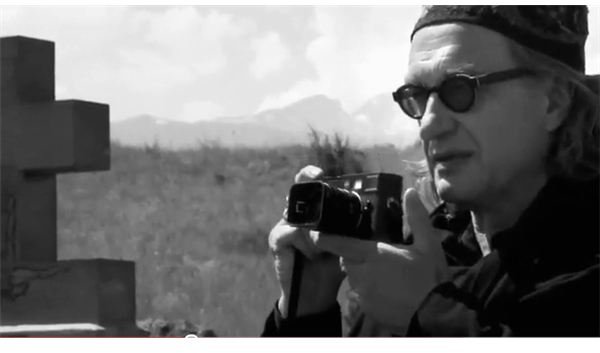The Photography and Films of Wim Wenders
Wim Wenders: Early Life
Wim Wenders was born on 14th August 1945; the Second World War had just ended and America, Great Britain, France and the USSR had occupied Germany. Wim Wenders was born in the British occupied zone in Dusseldorf. At the age of seven the young Wenders was taking photographs and by the age of twelve had his own darkroom. Wenders’ love of photography soon translated into wanting to make moving images and when he left school he attended the Hochschule für Fernsehen und Film between 1967 and 1970 in Munich, part of the American zone_._ Wenders understood that “the Yanks have colonized our subconscious” but still fell in love with all things American. Wenders is a fan of pinball machines, Americana, jukeboxes, gum, and rock n’ roll. During his time at film school Wenders made seven films consisting of six shorts and one feature film. Wenders left film school and managed to obtain for his first film “Die Angst des Tormanns beim Elfmeter” (The Goalie’s Anxiety of the Penalty Kick). The story for this film came from Peter Handke’s book of the same title; Wenders knew Peter well at the time. This film gave Wenders the break he needed as the film attracted international attention. Wenders’ next two films; “The Scarlet Letter” (1972) and “Alice in the Cities” (1973) both had American settings and although Wenders was unhappy with “The Scarlet Letter”, “Alice in the Cities” became the first in a trilogy of road movies that he made with Rüdiger Vogler. “The Wrong Movement” (1974) and “Kings of the Road” (1975) followed. “Wrong Movement” is often considered one of the most German of Wenders’ early films as John Sandford writes that it is; “reflecting on the melancholy resignation of European intellectuals in the mid seventies.” Wenders’ next work “The American Friend” (1977) made a name for him in America. Dennis Hopper and Bruno Ganz starred in this thriller that explored the relationship between America and Europe. Wenders went on to make the classic films “Paris, Texas” (1984), “Wings of Desire” (1987) and “Faraway, so close” (1993) both the latter films included appearances by the late Peter Falk. Wenders has also made unusual documentary films such as; “Lightning over Water” (1980) and “Tokyo-Ga” (1985). Wenders began making photography books and exhibiting photographic work in the early 1980’s. Wenders’ photographic works are reflections on places and are often devoid of people. Wenders had been taking photographs all through his career but stated in “The British Journal of Photography” in May 2011; “I’d been taking pictures for decades without printing anything; I was happy with my contact sheets and it just never crossed my mind. Printing was taking it seriously. Ever since that innocence has gone, I’ve become a photographer: I take pictures so that I can print them.”
Photographic Oeuvre

Wim Wenders began printing and making photographic monographs in the early 1980s. Wenders first started to print his images when he was searching for locations for the film “Paris, Texas.” Wenders had photographed many places with a medium format camera throughout the heartland of America; the resulting book “Written in the West” was published in 1987. “Written in the West” features the desolate landscapes and highways of Texas, California, Arizona and New Mexico. The images reflect the juxtaposition between nature and man made structures. These images are at the heart of how Wenders prefers to render his images as a mixture of documentary, offering narrative interpretation and landscape or portrait photography. Wenders has produced many other photographic books; some are connected to the films he has made such as the 1985 book “Tokyo-Ga.” This book contains Wenders’ diaries whilst he was making the film about Tokyo and the film director and writer Yasujiro Ozu. The “Buena Vista Social Club” published in 1999 as a companion to the film of the same name captures the beauty of the Cuban music scene and musicians. This book also contains text by Ry and Joaquim Cooder and Wenders made this book in collaboration with his photographer wife Donata.
Wenders has also made other purely photographic books such as: “Pictures from the Surface of the Earth” (2006), “Once”(1993), “The Million Dollar Hotel”(2000), “Off Scene” (20000 and most recently “Places Strange and Quiet” (2011). Wenders in “Pictures from the Surface of the Earth” captures desolate places such as in the image “On the Golan Heights” that shows a dead row of toll booths that have been cordoned off. Behind the booths is just a mass of desert, scrub and sky. From vast landscapes to “Safeway” in Corpus Christi, Texas; Wenders shows an emptiness that comes out of the nature of these structures and landscapes. In most the images there are no people but in some where people appear such as “On Alexanderplatz, Berlin” (1992) or “Beachfront. Tel Aviv” (2000), the people have their backs to the camera and are unaware of the intrusion. This technique does not give a sense of the people as we cannot see clearly their faces. These images give only a sense of how the landscape affects the people; in Berlin the men, all in army uniform, are engulfed in a white snow scene reminiscent of being trapped in a perpetually shaken snow globe. In Tel Aviv the purple hue of the night sky and artificial lighting renders the sky and lights center stage; the people seem to be mere actors in a scene that is played out over and over again. Wenders’ images are produced with a cinematic eye and all the images tell stories. With Wenders’ photographs you can travel the earth and visit places unknown and well-known, desolate and vast. Wenders presents the world and lets you consume it and in his images there is much to feast upon.
Theories of Photography

Over the course of his career Wenders has always been interested in the still image and has developed his own theories of photography. In “Pictures from the Surface of the Earth” Peter-Klaus Schuster states in the introduction that; “the digital electronic image will make the divide between ‘reality’ and ‘second-hand reality’ deeper than ever before, perhaps rendering it insurmountable. In other words, pictures have completely changed their being in the course of time, have been transformed from unique painted works into digital clones.” Klaus suggests that Wenders’ images are at “the end of photography”; they show things that are disappearing and due to endless copies, the idea of an original has ceased to exist. Wenders himself stated in an interview with “The British Journal of Photography” that; “I can take pictures with my iPhone theoretically, and I do every now and then, but I’m not a photographer with it – I’m an everyday man. Photography is a state of mind.” Wenders’ images create a magic and a mystery that is often lost in the digital landscape. His vast panoramas and isolated landscapes become fixed and Wenders believes that in contrast to his films; “the beauty of a single photograph is that it is enough in itself.”
References
Guardian UK: Wim Wenders: Places, Strange and Quiet
Awesome Stories: Occupation Zones of Germany after World War II
The British Journal of Photography: State of Grace: an Interview with Wim Wenders
Sandford, John, The New German Cinema, Oswald Wolff Publishers Ltd, London, 1980
Wenders, Wim, Pictures from the Surface of the Earth, Haus Publishing Ltd, London, 2007
Image Credits
Image One: “Wings of Desire” Film Still Flickr CC
Image Two: Kita Kamakura Cemetary where Yasujiro Ozo is buried Flickr CC Perke’s Photstream
Image Three: Wim Wenders: Movie for Leica Camera Screenshot from YouTube
